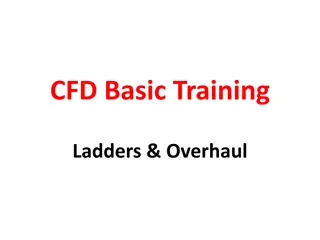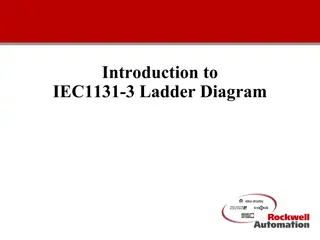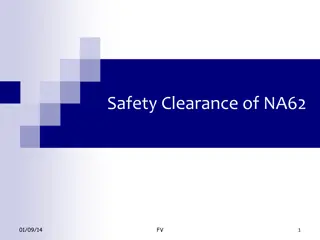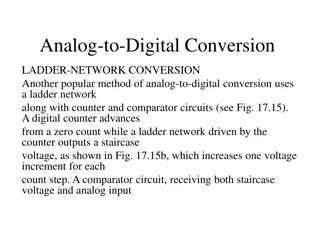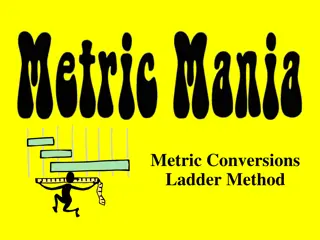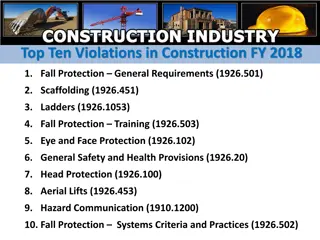Ladder Safety Training: Selecting, Using, and Maintaining Ladders
Understand the importance of selecting the right ladder for the job based on the work environment and physical requirements. Learn about ladder duty ratings, types of ladders, and proper care and maintenance practices to ensure safety at all times.
Download Presentation

Please find below an Image/Link to download the presentation.
The content on the website is provided AS IS for your information and personal use only. It may not be sold, licensed, or shared on other websites without obtaining consent from the author. Download presentation by click this link. If you encounter any issues during the download, it is possible that the publisher has removed the file from their server.
E N D
Presentation Transcript
Ladders Bureau of Workers Compensation PA Training for Health & Safety (PATHS) Basic Information & Safe Use Based on OSHA 29 CFR 1910.25-29 And 1926.1053 PPT-023-06 1
Selecting a Ladder Ladders are manufactured for specific a use; e.g. jobs that can be safely performed with step ladders could become dangerous if extension ladders used instead. You must evaluate the work environment and know what ladders are available before you can choose the right ladder for the job. Keep in mind all potential hazards: Electricity Uneven surfaces People and materials Overhead obstructions PPT-023-06 2
Selecting a Ladder You must keep in mind the physical requirements of the job: How much room will there be to position the ladder? How much weight-combining the user, tools, and materials-will be on the ladder? How long should the ladder be to safely perform the job? PPT-023-06 3
Duty Rating A ladder duty rating tells you its maximum weight capacity. There are four categories of the duty ratings: Type IA These ladders have a duty rating of 300 pounds and are recommended for extra heavy-duty industrial use. Type I These ladders have a duty rating of 250 pounds and are manufactured for heavy-duty use. Type II These ladders have a duty rating of 225 pounds and are approved for medium-duty use. Type III These ladders have a duty rating of 200 pounds and are rated for light-duty use PPT-023-06 4
Step Ladders Free from sharp edges, splinters, wane, & decay Type & Height: I = 3-20 (Industrial) II = 3-12 (Commercial) III= 3-6 (Home) Have a metal spreader or locking device PPT-023-06 5
Parts of a Step Ladder PPT-023-06 6
Portable Ladders Single/Straight ladder 30 feet or less Extension ladder 60 feet or less Painter s ladder 12 feet or less PPT-023-06 7
Parts of Extension Ladders PPT-023-06 8
Ladder Care & Maintenance Ladders must be maintained in good condition at all times: o Joints must be tight o Metal bearings of lock, wheels, pulleys, etc., must be lubricated o Frayed or badly worn rope must be replaced o Safety feet and other auxiliary equipment must be in good condition Ladders must be inspected frequently. PPT-023-06 9
Inspecting Ladders Recommended before each use. Check for broken, split, cracked, corroded or missing rungs and side rails. Check carefully for cracks (hard to see; cracks weaken ladders). Check for rungs or side rails with excessive bends (bent areas are greatly weakened and may fail during use). Check for loose, corroded, or weakened fasteners and hardware. PPT-023-06 10
Inspecting Ladders Check ladders for missing or damaged feet (ladder feet may have both non-skid pads for hard surfaces and metal feet for soft surfaces). Check for paint or other coating hiding defects (wooden ladders shall not be painted or coated with any opaque covering except for identification or warning labels placed on one face only of a side rail). Painted Aluminum, Fiberglass ladders = very hard to observe defects/damage. PPT-023-06 11
Inspecting Ladders Check for oil, grease, moisture or other slippery materials before use and clean as necessary. Check capacity label and make sure ladder has sufficient capacity to hold you and everything you are wearing/carrying. PPT-023-06 12
Safe Use of Ladders Make sure the ladder is strong enough and long enough for the job. Carefully inspect your ladder before you use it. Place the ladder on a firm, level surface with its feet parallel to the wall it is resting against. When ascending or descending, face the ladder and maintain 3 points of contact. Lift equipment and materials with a rope specifically for that purpose (don't carry equipment up a ladder with one hand). Carry smaller tools in pouches around the waist PPT-023-06 13
Safe Use of Ladders Don t over-extend sideways. Use the belt buckle rule: Keep your belt buckle positioned between the side rails at all times (this will maintain your center of gravity in the proper position). Do not move, shift, or extend the ladder while you are standing on it. Never walk a ladder. PPT-023-06 14
Safe Use of Ladders Do not load the ladder beyond its maximum intended load. Never allow more than one worker on the ladder at a time. Never stand on the top two steps of any ladder or the top cap of a step ladder (could cause you to become off-balance resulting in a fall). Carry ladders parallel to the ground. Tie ladders down securely when transporting. PPT-023-06 15
Safe Use of Ladders Always maintain 3 points of contact when working from a ladder Employee is maintaining three points of contact while working PPT-023-06 16
Safe Ladder Use Is it safe to use a ladder as a scaffold? NO! NO! NO! PPT-023-06 17
Safety Issues Here? Rail Bent Bracket Bent & Shelf Missing PPT-023-06 18
Safety Issues Here? Rail Bent PPT-023-06 19
Safety Issues Here? Missing Rungs PPT-023-06 20
Finally, Any Issues Here? Pin Loose- Coming Out PPT-023-06 21
Ladder Carry Two Person-Shoulder Carry PPT-023-06 22
Ladder Carry One Person-Shoulder Carry Safety: Worker not carrying drill by hand, but may want to remove bit while walking PPT-023-06 23
Ladder Carry One Person-Arm s Length Carry PPT-023-06 24
Straight Raise of Ladder PPT-023-06 25
Safe Ladder Set-Up No ladder used to gain access unless it extends 3 feet above the point of support. Your ladder must be tied off or placed to prevent slipping. When setting a ladder against a wall use the 4-to-1 ladder rule. PPT-023-06 26
Safe Ladder Set-Up PPT-023-06 27
Safe Climbing Angle PPT-023-06 28
Ladder Safety Precautions Ladders that have defects or are in need of repair must be removed from service. Shorter ladders must not be spliced together to make one big ladder. Rungs must be kept free from grease. PPT-023-06 29
Fixed Ladders The minimum design live load must be a single concentrated load of 200 pounds. All metal ladders and appurtenances must be painted. Rungs, cleats, and steps must be kept free of splinters, sharp edges, or burrs. PPT-023-06 30
Offset Fixed Ladders When ladders used to ascend to heights exceeding 20 feet, landing platforms must be provided for each 30 feet of height. All platforms shall be equipped with the standard railings and toeboards. PPT-023-06 31
Pitch of Fixed Ladders The preferred pitch of fixed ladders is considered to come in the range of 75 and 90 degrees with the horizontal. Substandard pitch is within the range of 60 and 75 degrees. PPT-023-06 32
Ladders and Electricity Metal ladders conduct electricity. Use care when placing. Suggest sign on metal ladders, not for use around electricity or electric lines. PPT-023-06 33
Summary Always choose the proper type of ladder for the job being done. Ladders need to be set up properly check surface and placement. Ladders should be used per manufacturer s recommendations. Never overload a ladder. A ladder inspection program should be in place. Defective ladders should be taken out of service and labeled appropriately. PPT-023-06 34
Bibliography 29 CFR 1910.25 Portable Wood Ladders 29 CFR 1910.26 Portable Metal Ladders 29 CFR 1910.27 Fixed Ladders 29 CFR 1926.1053 Ladders PPT-023-06 35
Contact Information Health & Safety Training Specialists 1171 South Cameron Street, Room 324 Harrisburg, PA 17104-2501 (717) 772-1635 RA-LI-BWC-PATHS@pa.gov Like us on Facebook! - https://www.facebook.com/BWCPATHS PPT-023-06 36
Questions PPT-023-06 37





